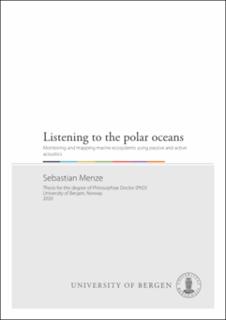| dc.contributor.author | Menze, Sebastian | en_US |
| dc.date.accessioned | 2020-06-03T12:22:16Z | |
| dc.date.available | 2020-06-03T12:22:16Z | |
| dc.date.issued | 2020-06-12 | |
| dc.date.submitted | 2020-06-03T07:45:38Z | |
| dc.identifier | container/2b/6e/c3/a1/2b6ec3a1-b3c0-40d1-9481-c12bf1f77361 | |
| dc.identifier.isbn | 9788230840498 | en_US |
| dc.identifier.isbn | 9788230856284 | en_US |
| dc.identifier.uri | https://hdl.handle.net/1956/22445 | |
| dc.description.abstract | This interdisciplinary thesis uses active and passive acoustics to study the polar marine ecosystems. The polar oceans are some of the most remote, harshest and least well studied environments of the planet, and also the regions where climate change and the associated changes in marine ecosystems happen fastest. The four papers that comprise this thesis are based on acoustic data from moored and vessel-mounted instruments and cover different aspects of the Arctic and Antarctic marine ecosystems. Vessel-mounted Acoustic Doppler Current Profiler (ADCP) data was used to map circulation patterns in the highly dynamical Fram Strait region. Such unstructured ADCP data is relatively seldom used in regional studies due to challenges associated with the interpretation of temporal and spatial variability. This was addressed by compiling a large data set, binning, different spatial interpolation methods and discussion of individual sections. The analysis showed that the Yermak Pass Branch can be as important as the Svalbard Branch in transporting Atlantic Water into the Arctic Ocean. The ADCP data was thereafter combined with vessel-mounted echosounder data and numerical modelling to investigate the impact of Atlantic Water circulation on plankton and fish distribution within four major troughs that cut into the Svalbard shelf. The Hinlopen Trough received the strongest and most direct Atlantic Water inflow and showed stronger acoustic backscatter from fish and zooplankton than the shelf, shelf break, and deep ocean. These results suggest that the balance between throughflow and retention creates favourable habitats in the trough for fish, benthic organisms and marine mammals. Passive acoustic data was used to study the sources and seasonal variation of ambient sound in the deep Southern Ocean. Passive acoustic monitoring has the advantage of autonomously and non-invasively gathering data over large spatial and temporal scales. The Southern Ocean, one of the last acoustically pristine oceans due to its remoteness and lack of infrastructure, is particularly well suited for such studies. Recordings from two moored recorders showed that ambient sound levels were strongly affected by the sea ice cover and local wind stress. Sound produced by marine mammals formed choruses that could be detected as population specific peaks in the long-term spectral averages. The temporal and spatial variation of these marine mammal choruses suggests seasonal patterns in migration and behaviour. A method to estimate the spatial distribution of acoustic sources (e.g. vocalizing animals) based on such chorus recordings was developed and tested, to resolve for marine mammal distribution and migration in ocean areas that are too large or remote to survey with traditional methods. Simulated annealing was used to estimate the distribution of acoustic sources on a geodesic grid, and the robustness of the method was tested with simulated scenarios using both drifting acoustic recorders (Argo floats) and a moored array as acoustic receivers. The results showed that inversion accuracy is only moderately reduced by inaccuracies in the sound propagation model. To then calculate the distribution of the vocalizing animals from the estimated acoustic source pressure distribution, the population specific call rates and source levels need to be considered. The four papers that comprise this thesis showed how encompassing the whole spectrum of acoustical oceanography, from echosounder and ADCP surveys to the analysis of passive acoustic recordings, allows us to study marine ecosystems from different angles. The papers use both a bottom-up approach, by mapping ocean currents and their impact on plankton and fish distribution, and direct approach towards the highest trophic levels, by monitoring the acoustic presence of vocalizing marine mammals. This thesis suggests multiple approaches to use acoustics to observe the under-sampled polar oceans and shows how utilizing often overlooked features in acoustic data can enhance our understanding of sparsely observed processes in remote ocean areas. | en_US |
| dc.language.iso | eng | eng |
| dc.publisher | The University of Bergen | eng |
| dc.relation.haspart | Paper 1: Menze, S., Ingvaldsen, R. B., Haugan, P., Beszczynska-Moeller, A., Fer, I., Sundfjord, A., & Falk-Petersen, S. (2019). Atlantic Water pathways along the north-western Svalbard shelf mapped using vessel-mounted current profilers. Journal of Geophysical Research: Oceans, 124(3), pp.1699–1716. The article is available at: <a href="http://hdl.handle.net/1956/20670" target="blank">http://hdl.handle.net/1956/20670</a> | en_US |
| dc.relation.haspart | Paper 2: Menze S., Nikolopoulos A., Hattermann T., Gjøsæter H., Albretsen J. and Ingvaldsen R. B. (2020) Productive detours – comparing Atlantic Water inflow and acoustic backscatter in the major troughs along the Svalbard shelf. The article is not available in BORA. | en_US |
| dc.relation.haspart | Paper 3: Menze, S., Zitterbart, D. P., van Opzeeland, I., & Boebel, O. (2017). The influence of sea ice, wind speed and marine mammals on Southern Ocean ambient sound. Royal Society Open Science, 4(1), 160370. The article is available in the main thesis. The article is also available at: <a href="https://doi.org/10.1098/rsos.160370" target="blank"> https://doi.org/10.1098/rsos.160370</a> | en_US |
| dc.relation.haspart | Paper 4: Menze, S., Zitterbart, D. P., Biuw, M., & Boebel, O. (2019). Estimating the spatial distribution of vocalizing animals from ambient sound spectra using widely spaced recorder arrays and inverse modelling. The Journal of the Acoustical Society of America, 146(6), 4699–4717. The article is available in the main thesis. The article is also available at: <a href="https://doi.org/10.1121/1.5139406" target="blank">https://doi.org/10.1121/1.5139406</a> | en_US |
| dc.rights | Attribution-NonCommercial-NoDerivs (CC BY-NC-ND) | eng |
| dc.rights.uri | https://creativecommons.org/licenses/by-nc-nd/4.0/ | eng |
| dc.title | Listening to the polar oceans : Monitoring and mapping marine ecosystems using passive and active acoustics | en_US |
| dc.type | Doctoral thesis | |
| dc.date.updated | 2020-06-03T07:45:38Z | |
| dc.rights.holder | Copyright the Author. | |
| dc.contributor.orcid | https://orcid.org/0000-0002-2680-9794 | |
| fs.unitcode | 12-44-0 | |

